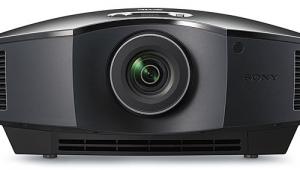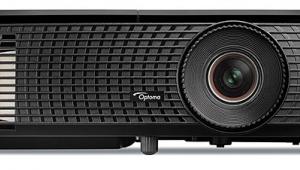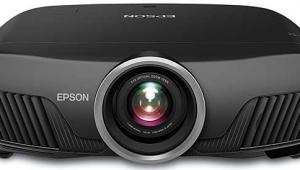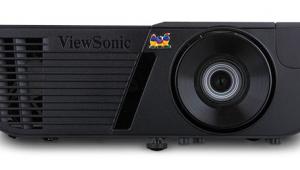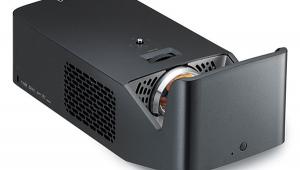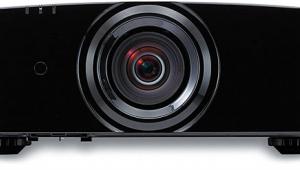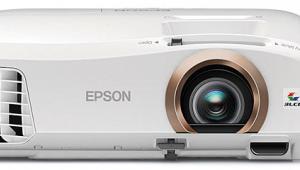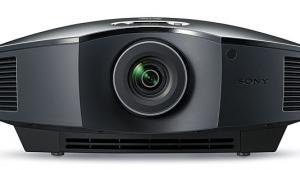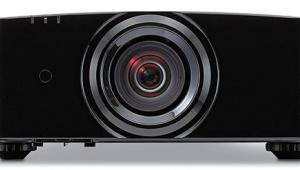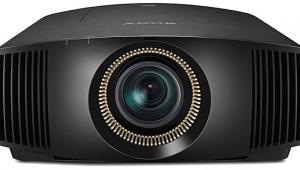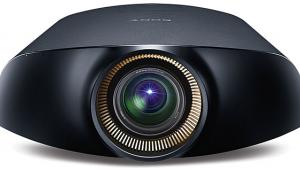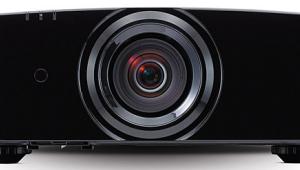I can't believe how good this projector is. It's definitely bright and if your a 3D fan it's fantastic. I upgraded from a DLP with non-existent black levels. Yes, there are better projectors that produce darker black levels. The color pops and this projector looks good in almost any light environment. For the money I can't believe what a quality projector this is. With a sale I caught + 10% movers coupon I was able to get this for $1169. A complete steal at that price. If you want a budget level projector with great quality...you can't go wrong with this one.
Epson PowerLite Home Cinema 3500 3D LCD Projector Review
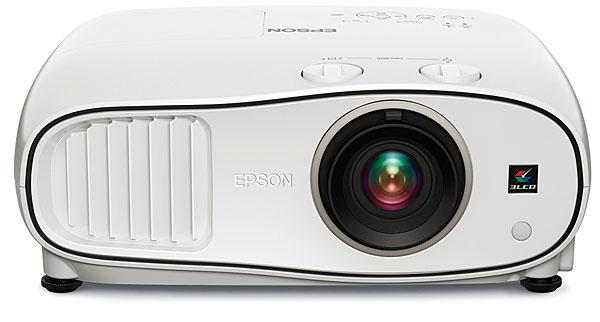
AT A GLANCE
Plus
Epson puts the “light” in PowerLite
Well suited for brighter environments
Adjustments galore
Includes two pair of 3D glasses
Minus
Dynamic range short of true black
Default color tracking errors
THE VERDICT
Powerful light output with quiet operation and excellent build quality partner with 3D at an attractive price.
Even for those of us within the electronics industry, the constant evolution and ascending levels of technology combined with an ever-lower price of admittance continues to astonish. In the universe of projected light, a stellar example of this can be found in the Epson PowerLite Home Cinema 3500 projector.
In Studio 1 of my lab, there remains a Runco DTV-1101 9-inch CRT projector that still sees use on special occasions. Not so much for the fondness of an era gone by; rather, because it is driven, pixel-free at 1080p resolution, by a Lumagen processor. This provides a reference bridge from the land we once knew across the Digital Rubicon to the world where we now reside.
I positioned the Epson directly on top of the floor-sitting Runco, with the intention to first audition the 3500 on the residing 87-inch-wide 16:9 Stewart StudioTek 130 G3 screen. When I initially sized the setup patterns within the Stewart’s boundaries, a wry smile crossed my face. I decided to use the green center-positioned lens of the Runco CRT to help center the Epson, as the 3500 has lens offset relative to the dimensions of its attractive, high-gloss white, 14.9-pound chassis. I couldn’t help but hear Joel Silver, head of the Imaging Science Foundation, in one of those Saturday Night Live off-stage voices, referring to how he would like 8K quantum dot technology today but is still waiting for the flying car promised some 50 years ago. The irony was precious: I was using a state-of-the-’90s-art, $45,000, 180-pound behemoth projector as a stand for a $1,600 light cannon that likely weighs about the same as that Runco lens by itself. Indeed, what a long, strange trip it’s been.
Setup
Priced well below the least expensive LCOS offerings of Sound & Vision mainstays JVC and Sony, the $1,600 3LCD Epson 3500 is positioned in the upper middle of the 16 models in the company’s Home Cinema projector category, and it’s $1,300 less than the Epson 5030UBe that Al Griffin awarded a Top Pick in April 2014.
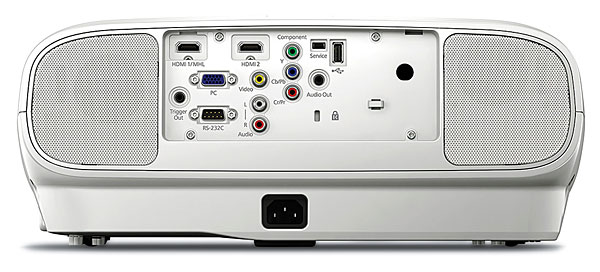
Nonetheless, the 3500 manages to include nine-point customizable gamma in addition to five preset gamma selections and adjustable high-range (Gain) and low-range (Offset) RGB White Balance controls. A full color management system (CMS) provides adjustment of hue, saturation, and brightness for the red, green, and blue primary colors as well as the secondary colors cyan, magenta, and yellow, making the projector highly versatile in the hands of a professional calibrator (or a suitably equipped enthusiast).
In the Image Settings menu, advanced adjustments coupled to the Sharpness control allow for Thin/Thick Line Enhancement for vertical and horizontal lines. Within the Signal menu, controls exist for Super Resolution (Detail Enhancement), which was best left at 1 for broadcast content and 0 for Blu-ray (though the latter had caused some unexpected modest dimming of light output). I left Image Processing in the Fine setting; Fast was strictly for gaming. See the expanded Test Bench section at soundandvision.com for more about the effect of these controls, which range from subtle (if not placebo-like) to outright ghastly.
Ten memory recalls came in handy while juggling measurements I made between two different screen mate- rials (see below). Each recall can be named using a default label such as Sports, Game, or DVD, or you can customize it with up to 12 characters.
Manual lens shift (if any at all) is the norm at this price, as are manual zoom and focus, and such is the case here. While not a benchmark in precision machining, the Epson’s lens shift, with 60 percent vertical and 24 percent horizontal range, is purposeful, though the horizontal and vertical lens shifts were somewhat interactive and necessitated a bit of finesse to land perfectly at the sweet spot.
Alignment of the internal red, green, and blue 0.61-inch thin film transistor LCD panels is accomplished via a 176 multi-point system affording precision convergence—that capability is something of a surprise at this price. Panel convergence was good out of the box, though, and a check of adjustment parameters revealed that some alignment was probably done at the factory, with the horizontal and vertical registries indicating input data. At the 100-hour mark on the lamp timer and prior to calibration, a recheck indicated that some maintenance alignment was required to restore the same image “snap” as when first unboxed. It’s worth noting that panel alignment adjustments don’t literally manipulate the physical panel positioning but are made through digital compensation, and overdoing this can inject noise subtleties that mar fine image details. But from my viewing distance, a bit of touch-up proved beneficial and didn’t hurt the overall clarity.
There are three modes for lamp intensity (labeled Power Consumption): ECO, Medium, and High. In ECO (where I ran the unit between the two studios and screen sizes), the fan was inaudible a few feet from the unit. Selecting Medium or High presses the accelerator on lumen output and ramps up fan speed, which is discernible absent an audio soundtrack playing over the fan. A bit of light leaks from the projector, but the louvers for the front-ported fan exhaust are at an angle, allowing only a muted glow from the optical chamber when viewed directly front-on. Epson estimates nominal lamp life to be 3,500 to 5,000 hours, depending on mode, but given what I deem to be a bargain of an acquisition price for the projector, I wouldn’t be shy about retaining optimum performance with more timely lamp replacement.
As with most products these days, the manual is on a disc, but Epson also makes it available and searchable online. Kudos to Epson for the depth of documentation—a lost art that other manufacturers should consider emulating.
The included, backlit remote has a solid feel with direct access to every input and adjustment category.
Plug and Play
I eventually decided on using the Epson in my Studio 2 (the larger of the two), employing a 106-inch-wide (122-inch-diagonal) 16:9 Stewart FireHawk G3 screen, as that better represents the more common application of this type of machine. Not so much this particular Stewart screen, which would cost more than the projector, but one might expect this projector to land in an environ-
ment with differing levels of ambient light and with a screen made to address that task. With walls of light brown, which Munsell color classification defines as nearly neutral, this space typifies a multipurpose environment rather than a dedicated home theater.
With the Epson placed upon a tallish equipment rack that positions most projector lenses near the middle of the screen with minimal lens shift, the resulting throw distance from the 122-inch-diagonal screen was 18 feet, 5 inches, with plenty of wiggle room. Epson specifies a throw ratio of 1.32 (Zoom: Wide) to 2.15 (Zoom: Tele) from the 1.6:1 zoom lens.
I watch a great number of NHL games from broadcast, as well as live. I’m fortunate to have a rock- solid cable provider that delivers impressive signal quality, and with the Epson, I found myself pulled into the action seconds after the opening face-off. In many ways, hockey is an excellent torture test for evaluating all aspects of a display device. Even the untrained eye can quickly determine if the ice looks white or imbued with a color hue, so it equally serves as a real-life grayscale test. Fast camera turns that follow speedy on-ice action against the backdrop of fixed signage on the “boards” produce never-ending challenges for motion processing. With the Motion Detection setting at 4 for networks broadcasting at 1080i, not once did the Epson ever give me pause to question its aplomb in this regard. (This function is defeated with a progressive-scan incoming signal.)
Epson claims the 3LCD architecture offers equal lumens of color brightness and white bright- ness, and I’m convinced: The 3500 made team uniform colors leap off the screen. Mind you, not with the neon-like syrupiness of oversaturation you see from boosting the color control; that was set to 0. I felt like I had a seat on the glass behind the home bench. So enamored was I after a few days of use that I began juggling my schedule to make time to watch games, looking forward to the big, dynamic image and smooth fluidity of motion delivered by this projector performing as my everyday TV.
Worth an incidental mention is the Epson’s built-in audio. Unorthodox as it appeared and eager to get an image up and running, I initially connected the unit via HDMI to the output of a Cisco cable box, pre- suming with a passing chuckle that it would sound like a 1950s AM radio. Boy, was I surprised. The dual 10-watt speaker set easily filled my Studio 2 with clear, articulate audio. If using this feature factors into your plans (say, for a poolside viewing party), you might find yourself eminently satisfied.
- Log in or register to post comments

